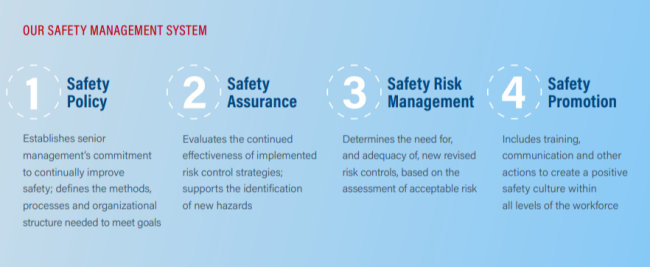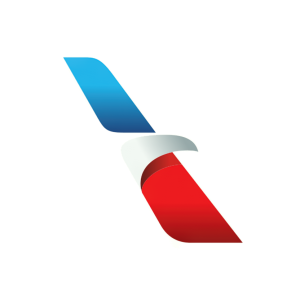American Airlines' Safety Management System
Rhea-AI Summary
American Airlines reaffirms its commitment to safety through its comprehensive Safety Management System (SMS), which has been integrated into FAA regulations since 2009. The SMS focuses on proactive risk management, emphasizing a culture of safety that involves all employees. Key components include a Safety Policy, Emergency Response Manual, and regular safety reporting. The airline utilizes innovative technology and extensive data analysis to enhance safety measures, reduce injuries, and improve operational efficiency. Monthly updates on safety metrics are given to leadership, ensuring ongoing focus on risk management.
Positive
- Successfully completed IOSA audit, renewing registration until July 2024.
- Introduced new technology for turbulence detection to enhance crew safety.
- Launched the Learning and Improvement Team to analyze pilot success factors.
Negative
- Increased team member injury rates in 2021 due to ramping up operations post-pandemic.
- Five out of six recorded accidents in mainline operations were attributed to turbulence.
News Market Reaction 1 Alert
On the day this news was published, AAL declined 3.15%, reflecting a moderate negative market reaction.
Data tracked by StockTitan Argus on the day of publication.
NORTHAMPTON, MA / ACCESSWIRE / December 15, 2022 / The safety of our customers and team members is guided by our Safety Management System (SMS), an organizationwide approach to identifying and managing risk. American was the first U.S. carrier to pioneer SMS in 2009. It has since been incorporated into Federal Aviation Administration (FAA) regulations for all carriers.
Our SMS emphasizes safety management as a fundamental business process across the enterprise. It involves a full commitment from the most senior leaders through to each team member to integrate safety into how we do our jobs. Our SMS promotes a culture in which our team members proactively identify, analyze and mitigate risks. The SMS ensures robust and repeatable processes with local ownership, driven by data to reduce risks and continuously improve and enhance safety. We collaborate closely with the FAA to maintain operational safety at the highest level possible and actively share best practices with our industry peers, governments and aerospace manufacturers. The four components of our SMS are noted in the accompanying box.
Safety Policy
Our corporate Safety Policy applies to all team members, business partners, contractors and consultants. It sets American's safety objectives and standards and assigns responsibilities for safety across our organization. The policy also conveys management's commitment to safety performance and to improving the level of safety through measurable goals and key performance indicators. Part of our SMS foundation, this policy helps to create a culture that encourages effective management of risk along with continuous improvement. The Safety Policy complies with all applicable regulatory requirements and laws in the countries where we operate and establishes standards for acceptable operational behaviors.
Our Emergency Response Manual (ERM), which establishes effective and efficient response practices for various types of emergencies, is an integral part of our SMS. The ERM serves as the governing document for the American Airlines Corporate Emergency Response Plan. It includes guidelines to prepare for and respond to emergencies, responsibilities for team members, protocols for communicating with internal and external stakeholders and mechanisms to report emergencies. The ERM also includes a detailed Pandemic Preparedness and Response Plan that helped us navigate through every phase of the COVID-19 pandemic.
Safety Assurance
The Safety Assurance component of our SMS stipulates how we use data and conduct quality assurance and internal oversight to validate the effectiveness of risk controls and the performance of the SMS. Composed of several individual programs and initiatives, Safety Assurance verifies that risk controls in our operational processes continue to conform to requirements and remain effective in maintaining risks at acceptable levels.
Safety Reporting
Our senior leadership team, which includes our Chief Executive Officer and Chief Operating Officer, receives monthly updates on team member safety and risks across our system. We focus on injury reduction, evaluate trends and develop programs to enhance safety. We are centralizing our data collection and injury reporting tools to provide better visibility, simplicity and easy access for company leaders. In addition to monitoring injury rates, we closely track aircraft ground damage, both as a part of our safety culture and because it is correlated with on-the-job injuries.
After a significant decline from 2019 to 2020, team member injury rates in our mainline and regional operations rose along with the increase in our operations in 2021. The challenges associated with ramping up our operations as demand returned and introducing new and returning team members back into our operations contributed to this increase. We remain focused on reducing injuries and redoubling our efforts to enhance our health and safety policies and procedures and elevate our safety culture. In 2021, we also experienced an increase in accidents in our mainline operations; five of the six recorded accidents were due to turbulence that caused crewmember injuries. As a result, we are implementing new technologies that pilots can use while en route to identify upcoming turbulence, updating flight attendant procedures for anticipated and forecasted turbulence, and expanding our use of data analysis by our Turbulence Task Force.
The overall goal of team member reporting is to improve safety awareness and identify operational deficiencies by facilitating an open line of communication between the employees and management without fear of reprisal. Potential safety concerns and suggestions identified through our many safety reporting programs are critical to early identification of hazards. These reports also allow the company to proactively address potential risks and implement corrective actions to resolve safety and security issues.
When a team member identifies any safety-related concern, he or she is encouraged to report the issue. Once the concern is received, skilled safety investigators collaborate with operational partners to review the information provided, assess the hazard and develop corrective actions to ensure the issue is addressed. These reports are then reviewed as part of the broader SMS to determine if there are system related risks developing. We follow up with the reporter to communicate what we learned and what steps we are taking to prevent similar concerns from arising again. This followthrough and prompt action helps encourage additional reporting, thus creating a robust safety reporting life cycle.
Our most prominent safety reporting initiatives include the following: Aviation Safety Action Programs, Ground Safety Action Programs, Flight Operations Quality Assurance, the International Air Transport Association's Operational Safety Audit, Line Operations Safety Audits, and the Learning and Improvement Team.
Safety Action Programs
Everyone at American has a role to perform in ensuring that our people, customers and assets remain safe. Through Aviation Safety Action Programs (ASAPs) and Ground Safety Action Programs (GSAPs), team members can openly report potential hazards without concern of fault, thus improving our operations along the way.
American was the first airline to create an ASAP, although such programs are now commonplace among airlines worldwide. Currently, we have ASAPs for our Flight, Flight Service, Dispatch, Technical Operations and Central Load Planning teams, giving us significantly greater coverage than the industry average. In 2021, we recorded 10,847 ASAP reports. We expect to roll out programs in 2022 for Gate Agent and Crew Scheduling teams, which will give us ASAP coverage across
Our GSAP for Fleet Service and Cargo teams plays the same role, encouraging team members to report potential safety issues in cargo and catering environments, control centers and on the ramp. This program was created in collaboration with the Transport Workers Union of America-International Association of Machinists & Aerospace Workers and the FAA. In 2021, we recorded 487 GSAP reports.
Flight Operations Quality Assurance (FOQA)
FOQA is a voluntary safety program administered jointly by American and the Allied Pilots Association (APA) that uses routinely recorded flight data to proactively identify and correct deficiencies in flight operations. We routinely monitor approximately
To enhance FOQA's effectiveness, American partnered with Collins Aerospace in 2021 to retrofit our narrowbody aircraft with its Aircraft Interface Device (AID). The entire fleet at American will be equipped with this wireless data transfer system by the end of 2024. AID improves the speed with which we can retrieve FOQA data, and it represents an important step toward increasing accuracy in monthly reporting, improving aircraft reliability and preparing for future products and capabilities.
American will also be the first carrier in the United States to adopt CEFA Aviation Mobile Services, a cloud-based application that allows pilots to recreate their flights on their company iPad. This tool will improve on the concept of crew debriefing by providing real-time feedback to our pilots. It turns each flight into a learning opportunity, ultimately contributing to the safety assurance of our SMS.
International Air Transport Association's Operational Safety Audit (IOSA)
As part of our commitment to transparency and monitoring, we are a registered participant in the IOSA program, which is an internationally recognized evaluation system designed to assess an airline's operational management and control systems. An IOSA, which takes place every two years, creates a structured methodology with standardized checklists that are comparable on a worldwide basis, enabling and maximizing the joint use of audit reports. In April 2022, we successfully completed our IOSA audit in conformance with all standards and recommended practices. As a result, American Airlines IOSA registration has been renewed until July 2024.
Line Operations Safety Audits (LOSA)
Since launching our continuous pilot LOSA program in 2017, we have been sending highly trained pilot observers onto the flight deck to better understand work-as-done versus work-as-imagined. Observing our frontline team members in action and gathering safety-related data on environmental conditions, operational complexities and crew performance in real time provides us with valuable insights for enhancing safety and resilience.
We are expanding LOSA to other work groups outside our pilot group. In 2021, we implemented a continuous Dispatch LOSA and are collecting data to enhance safety performance. We also are developing a Cabin LOSA program and expect to start conducting observations in 2023. The Cabin LOSA program will help us better understand the challenges facing our flight attendants and the measures we can take to keep the cabin safe for everyone. We will continue to evaluate the feasibility of expanding LOSA to other operational groups, with
"The Learning and Improvement Team is the latest addition to our Flight SMS programs. By focusing on what we do well, it complements the programs that concentrate primarily on areas where we need to improve."
- Bobbi Wells
Vice President, Safety Systems, Efficiency and Compliance
Learning and Improvement Team (LIT)
We created LIT in 2022 to collect and analyze data on what makes our pilots successful in their everyday work. LIT is composed of line pilots who are specially trained in flight deck observations and facilitated discussions. While it is similar in some ways to LOSA, LIT is a separate program. One of the key differences between LIT and American's other Flight SMS programs (i.e., ASAP, FOQA, LOSA) is that LIT focuses on what goes well and why, thus providing a new safety lens through which to view the operation. Combining LIT data with other SMS data provides American with a broader picture of the system, rather than looking solely at unwanted outcomes.
Efficiency and Continuous Improvement Team
Learning and continuous improvement are essential to a robust safety program. This new team at American will solicit input and suggestions from frontline operational employees on how to improve the efficiency of the operation without compromising safety. Deferring to the expertise and input from these employees, all ideas and suggestions will be reviewed and vetted through our formalized SMS process. Employees may submit feedback and suggestions through their safety reporting programs, directly by email or by scanning the QR code on a card that is handed out during efficiency and safety meetings and posted in select locations.
Safety Risk Management
The Safety Risk Management (SRM) element of our SMS provides a decision-making process for identifying hazards and mitigating risk based on a thorough understanding of our systems and their operating environment. SRM enables us to consider the risks in our operations and reduce them to an acceptable level. We use the SRM process whenever there is a significant change to our operations, such as delivery of a new type of aircraft or the addition of a new airport to our network. We also apply SRM when our Safety Assurance process identifies a new hazard or an ineffective control of an existing hazard.
We use several tools to identify hazards and evaluate the need for new or revised risk controls. The process of risk management is the same regardless of the trigger or event, and our SMS looks at multiple factors for risk. While the FAA requirements are geared toward flight safety, our SMS goes further to evaluate a wider range of global risks, including operational disruptions.
Safety Promotion
Safety culture is the foundation of any SMS, with trust at the core. At American we believe in a Just Culture approach, which encourages each team member to take responsibility and have accountability for achieving the highest safety standards and results. This approach, which we have championed for more than a decade and has since become an accepted aviation industry standard, encourages team members to report errors, risky decisions or omissions without fear of punitive actions. We train our teams to look at potential safety events using three types of behaviors: human errors, at-risk behavior and reckless behavior.
Safety Training
Our ramp agents have the highest rate of injuries among all team member groups, primarily as the result of lifting baggage, often in awkward and tight spaces. Working with Pristine Condition International, which introduced the science of Olympic weightlifting techniques to industry, we recently conducted a training program on proper lifting techniques. This initiative included bringing athletic trainers to our busiest airport hubs to work with ramp agents on body mechanics and fitness. Our flight attendant group has the second-highest rate of injuries, followed by aircraft mechanics, and we have initiatives underway to reduce these rates as well. For example, we produced three new seatbelt safety videos for team members based on actual incidents.
Turbulence Task Force
In 2021, our Turbulence Task Force completed serving its original charter to reduce flight attendant and passenger injuries during flight, and now the identified hazards and concerns are addressed in our established and approved SMS process. The program proved highly successful.
StaySafe and Safety Engagement Tool
StaySafe is a safety communications campaign implemented across our airport and technical operations organizations. Its materials focus on lessons learned and ways to prevent team member injuries and equipment damage. Any bulletins or alerts are available across multiple platforms in order to reach all team members.
Through our new Safety Engagement Tool, we are bringing company leadership to the frontlines to engage in conversations with team members. Managers can communicate safety expectations, assess risks in the operation and reinforce safe behaviors.

View additional multimedia and more ESG storytelling from American Airlines on 3blmedia.com.
Contact Info:
Spokesperson: American Airlines
Website: profiles/american-airlines
Email: info@3blmedia.com
SOURCE: American Airlines
View source version on accesswire.com:
https://www.accesswire.com/732017/American-Airlines-Safety-Management-System







